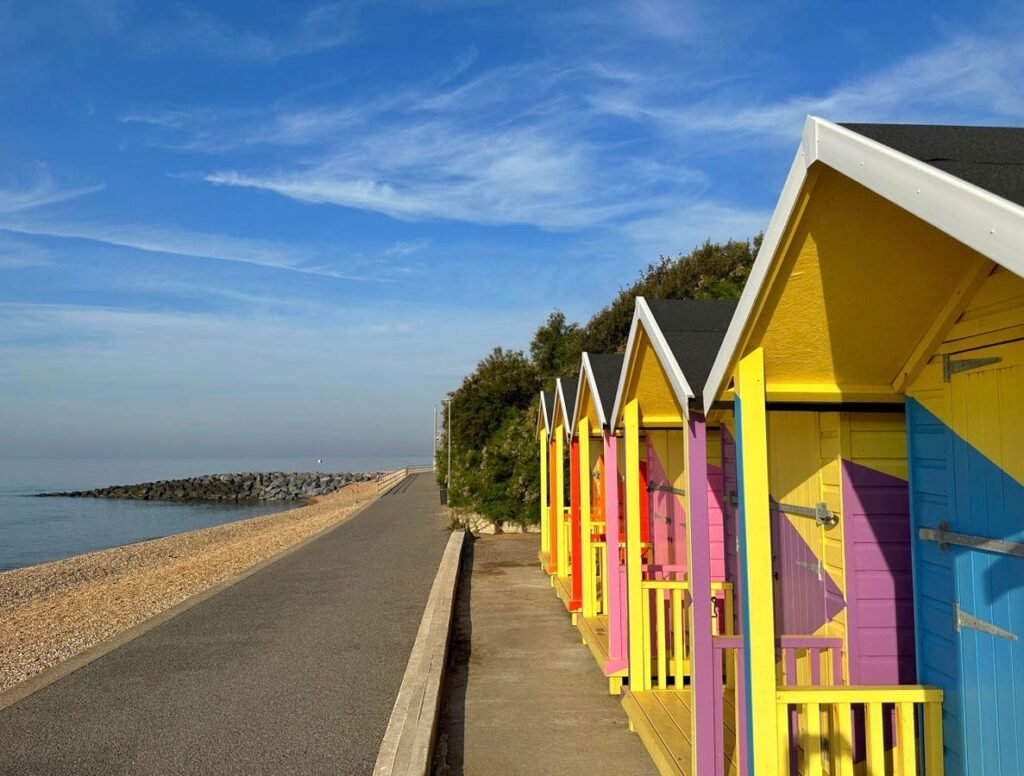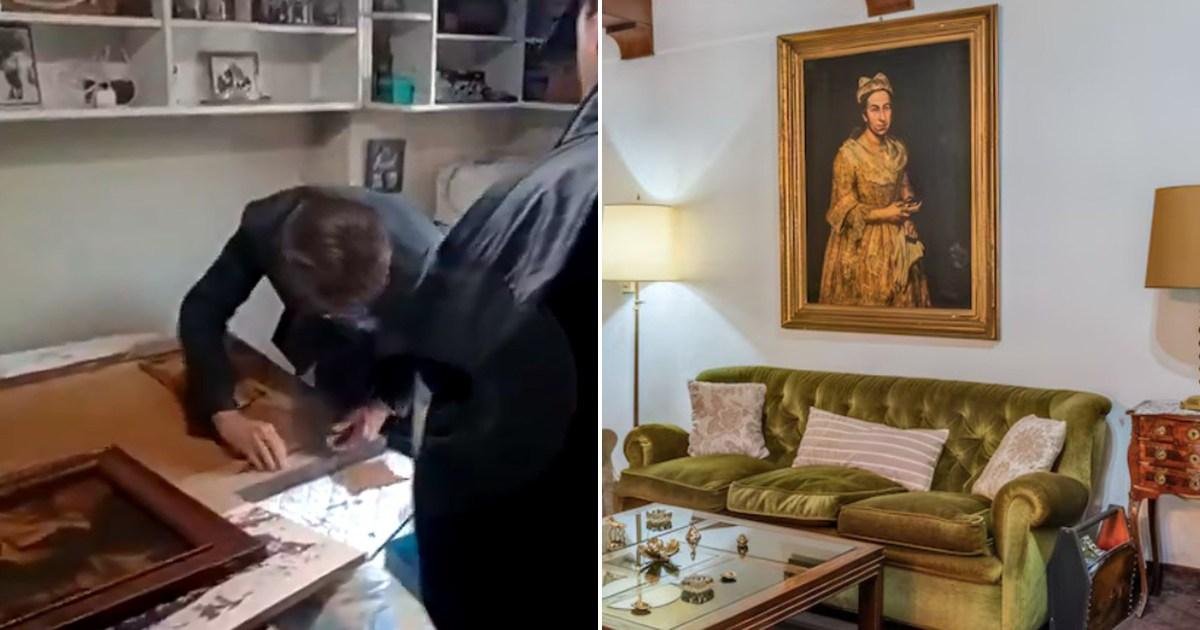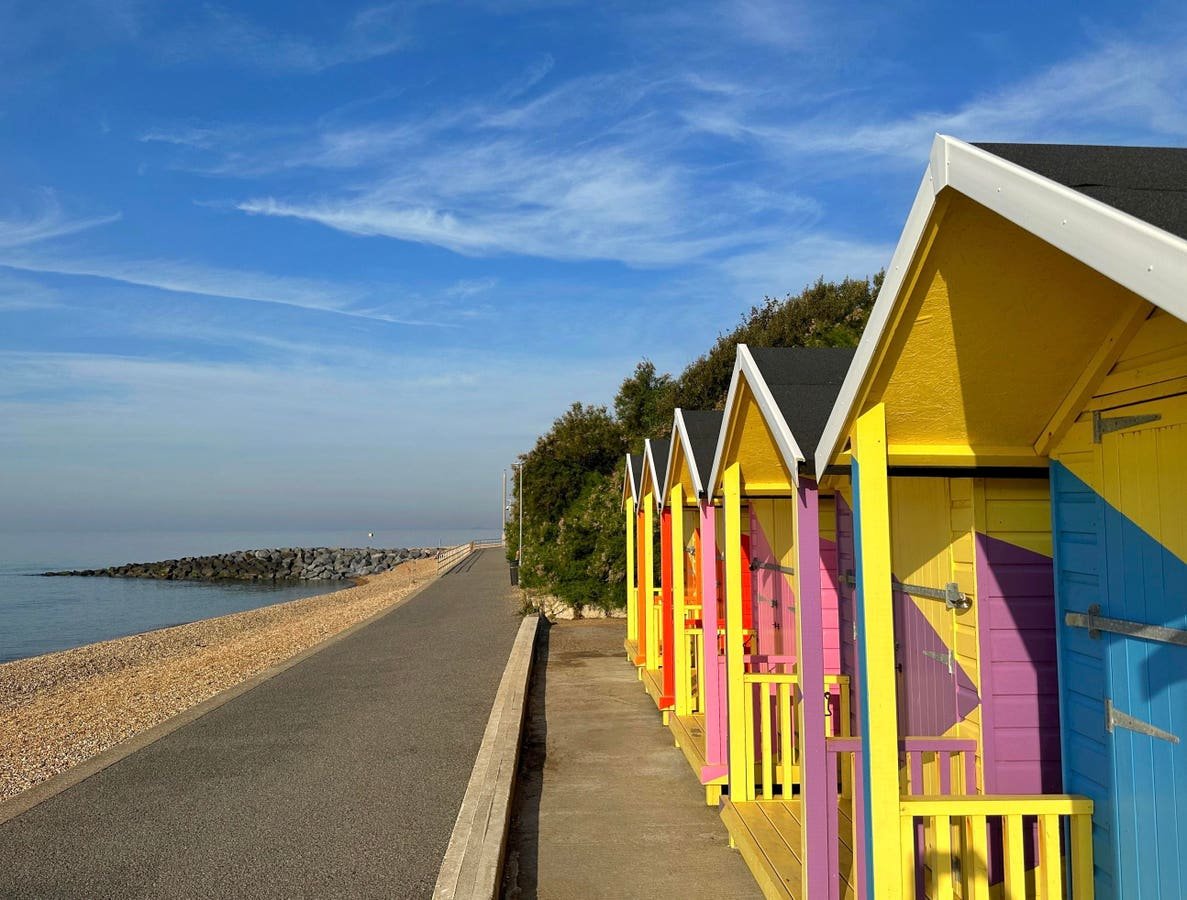Colorful wooden beach huts, Folkestone, Kent, England, UK
getty
In less than an hour by bullet train from London, you will have a clear view of the French coastline from Folkestone, on the English Channel. The quirky seaside town is not only one of England’s classic beach holiday towns but a brilliant setting for the sixth edition of the Folkestone Triennial, an international, open-air art exhibition. The triennial runs until 19 October 2025 and features 18 artists from 15 countries, all whom have created new commissions scattered along the waterfront and throughout the town. Visit for the day for an art tour or stay overnight to also enjoy a swim and seafood.
One of Celine Condorelli’s flag sculptures at Folkestone Triennial, 2025
Thierry Bal
Organised by Creative Folkestone, How Lies the Land? curated by Sorcha Carey (former director of Edinburgh Art Festival), explores the layers of history embedded in Folkestone’s geography, its deep past, shifting borders, and evolving landscape. This edition’s commissions have taken over some of the town’s most striking and unusual locations, including a church built for the fishing community, a former customs house, a Martello Tower and a disused railway bridge. From large-scale installations to immersive soundscapes, collaborations with local communities, through to computer simulations, designs for a new playground, amulet filled towers, a Ministry of Sewers and creatures like a three headed bird, the artists have responded to the town’s geological, social and political history. Some of the works can be encountered and admired quickly but others are better enjoyed if you take the time to sit, watch and contemplate. This applies especially to the film and audio works which are a strong feature of this triennial. Here are a few must-see pieces in the exhibition.
Emeka Ogboh, “Ode to the Channel” sound installation, Folkestone Triennial 2025
Paul Allen/ Andfotography2
Emeka Ogboh’s “Ode to the Channel” is a haunting sound installation off the boardwalk in a seaweed covered tunnel leading to the rocky beach. The artist was inspired by Sanjeev Gupta’s theory that the English Channel was created by a “megaflood”, a catastrophic climactic event taking place around 450,000 years ago which breached the land bridge connecting Britain to Europe, to create the island landmass we now know as Britain. The artist worked with locally based songwriter Rachel Gerrard, and six local singers (The Sirens) who’ve created acapella female voices that sing out, siren-like through a seriously impressive set of speakers.
Katie Paterson, Afterlife, Folkestone Triennial, 2025
Thierry Bal
Katie Paterson’s fascinating “Afterlife” is installed in a Martello tower, a circular structure built for defence around Britain’s coastline during the Napoleonic wars. As the tower has been closed to the public for decades, the Triennial offers a rare opportunity to enter the historic building. Inside is the artist’s collection of “Amulets,” miniature stone objects historically thought to protect. The installation reimagines this tradition with 200 ancient amulets from across time and all corners of the globe, that can be seen in museums worldwide, representing Mesopotamian, Egyptian, Viking, Islamic, Japanese, Indian, Chinese, Celtic, Greco-Roman, and Pre-Columbian traditions. The actual amulets here have been recreated from materials sourced from endangered landscapes and fragile ecosystems reflecting the pressing environmental issues of our time. Rocks from glacial terrains left bare by retreating ice, coral from the Great Barrier Reef, stones from islands facing rising sea levels, and other materials from devastated or threatened ecosystems are transformed into tiny objects of reflection, connection, prayer and renewal.
Emilija Škarnulytė, Burial, 2022, film, 60′. Folkestone Folkestone Triennial, 2025
Emilija Škarnulytė Studio
Emilija Škarnulytė’s Burial is a mesmerising, immersive film experience, well worth worth watching until the end (it’s just under an hour long). Considering the proximity of Folkestone to Dungeness nuclear power station, currently in process of being decommissioned, this seems the ideal location to screen a film about a Lithuanian nuclear station. Burial explores the thorny issue of what to do with nuclear waste, taking the viewer on an immersive sensorial trip into Ignalina Nuclear Power Plant (INPP) in Lithuania, created as a sister to Chernobyl at the height of the Cold War, and now undergoing a decommissioning process as a condition of Lithuania’s admission to the EU.
John Gerrard, Ghost Feed at Folkestone Triennial, 2025
Thierry Bal
John Gerrard’s “Ghost Feed” is installed on a disused railway bridge beside Rocksalt restaurant. On a large scale LED screen, a white cheeked spider monkey sits hunched over a smart phone within a smouldering virtual Brazilian forest landscape, occasionally glancing up at his viewers. The phone shows an actual video feed of the character’s face. Made entirely within the Unreal game engine and slowly moving from day to night, this fascinating simulated world poses questions about consumption, technology, immobility and ecology.
Dorothy Cross, Red Erratic, Folkestone Triennial 2025
Paul Allen/ Andfotography2
Dorothy Cross’s “Red Erratic” an imposing sculpture made of a seven ton rose marble block shipped from Syria, sits on a loading bay on Folkestone Harbour Arm. Erratic is a geological term used to describe a rock which has been moved by a glacier over time and deposited in a new landscape. In “Red Erratic,” human feet emerge from the marble, perilously positioned one on top of each other as if to gain a foothold. Today’s forced evacuations and migrations come to mind in this timely piece.
Still from Sarah Wood’s film Prospect at Folkestone Triennial, 2025
Paul Allen/ Andfotography2
Sarah Wood’s film installation “Prospect” showing in a small hut in the old town overlays archival footage taken by Derek Jarman, as part of his preparations for The Garden, with a new soundscape woven from contemporary field recordings. Taking the form of an address to Jarman, Prospect imagines the emigrants who set sail at the end of Jarman’s film The Last of England returning to Britain. What kind of welcome would they find, and what would help them survive? Wood’s essay film invites us to tune into the warmth of Jarman’s creative process, and looking beyond Jarman himself, to reflect on “art’s potential to generate open space for complexity, inclusivity, companionability, vision – and the radical nature of love.”
Where to Stay
If you want to take your time exploring the triennial, stay overnight at one of two charming 4-star hotels on the harbor: London and Paris hotel or Rocksalt, both excellent choices.
London and Paris Hotel, Folkestone
London and Paris
London and Paris hotel, on Harbour Street, is part of the L&B group founded by Lucy and Ben Cuthbert who own six other venues in town and The Famous Ship Inn in nearby Sandgate. The eleven individually designed rooms of various sizes each have a mix of attractive vintage furnishings and harbor views. Dining, including an impressive a la carte breakfast, is directly downstairs in the Harbour Inn or the adjoining pub.
A guest room at Rocksalt, Folkestone
Rocksalt
Rocksalt has four boutique rooms, each different in design but all with original antique beds, flat screen televisions and wet rooms. The rooms have sea views and are located right among the working fishing harbor, a short walk from Rocksalt restaurant where guests can enjoy breakfast on the harbor-side terrace.
Where to Eat and Drink
Rocksalt dining room with terrace
Rocksalt
Rocksalt restaurant sources ingredients as locally as possible: from the day boats working along the South Coast to local farms. Current menu highlights include chilli and garlic shell-on king prawns, and Folkestone scallops. Rocksalt’s Wine Bar, on the first floor above the restaurant has a beautiful sun deck for the summer months. Hotel guests have breakfast here.
The Harbour Inn’s Dining Room, Folkestone
L&B
The Harbour Inn’s Dining Room is a charming option for both visitors and guests of the London and Paris hotel upstairs. Menu highlights include King Prawn Pasta and the hot platter with half grilled lobster, dressed crab, mussels and more. The pub attached to the Harbour Inn hotel is great for drinks and fish and chips.
Lobster at SeaSellsSeaShells, Folkestone Harbour
Joanne Shurvell
Located in a vintage railway carriage at platform three of the former Folkestone Harbour train station, SeaSellsSeaShells is a unique quayside dining experience with excellent seafood. The family-run restaurant specialises in moules and lobster, handpicked daily from the Folkestone trawlers.
Folkestone Triennial sign 2025
Paul Allen/ Andfotography2
The participating artists in Folkestone Triennial 2025
Dineo Seshee Raisibe Bopape, Céline Condorelli, Monster Chetwynd, Dorothy Cross, john gerrard, J Maizlish Mole, Rubiane Maia, Emeka Ogboh, Prabhakar Pachpute, Katie Paterson, Laure Prouvost, Cooking Sections, Emilija Škarnulytė, Rae-Yen Song 宋瑞渊, Jennifer Tee, Sara Trillo, Hanna Tuulikki and Sarah Wood.
Getting There
Travelling from London to Folkestone is a breeze by train from St Pancras station where regular trains take less than an hour on the high speed Dover service.






